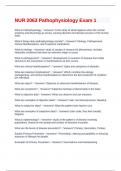NUR 2063 Pathophysiology Exam 1
What is Pathophysiology - *answers* is the study of what happens when the normal
anatomy and physiology go wrong, causing disorder and disease process of the human
body.
What 4 things does pathophysiology include? - *answers* Etiology, Pathogenesis,
Clinical Manifestations, and Treatment Implications
What is etiology - *answers* study of causes or reasons for phenomena. Includes
Idiopathic conditions that have an unknown origin or cause.
What is pathogenesis? - *answers* development or evolution of disease from initial
stimulus to the expression of manifestations as time occurs.
What are clinical manifestations? - *answers* Signs and symptoms of disorder.
What are treatment implications? - *answers* Which combine the etology,
pathogenesis, and clinical manifestations to determine the best treatment of condition
per individual.
What are signs? - *answers* Objective or observed manifestations of disease.
What are symptoms? - *answers* Subjective feelings of abnormality in the body.
What is objective data - *answers* What you observe and can measure.
What are examples of objective data? - *answers* rash, low blood pressure, bleeding
What is subjective data? - *answers* What the patient may report to you
What are examples of subjective data? - *answers* pain scale, they feel suicidal,
fatigued.
What is epidemiology? - *answers* study of the patterns of disease involving
populations. Based on the spread and contact of diseases in people.
What are the levels of disease prevention? - *answers* Primary, Secondary, Tertiary
Explain Primary Prevention - *answers* "Preventing"; altering susceptibility or reducing
exposure of disease for people.
Examples of Primary Prevention - *answers* Vaccinations and Handwashing
,Explain Secondary Prevention - *answers* "Screening"; early detection, screening, and
management of disease to catch disease early before it spreads
Examples of Secondary Prevention - *answers* PAP smears for STDs, lab work for
HBA1C check, mammogram
Explain Tertiary Prevention - *answers* "Treating" and preventing further complications
from a disorder or disease after the person has the condition
Examples of Tertiary Prevention - *answers* Rehab for hip surgery, relearning ADL's
after amputation, Wound care after stroke to prevent pressure ulcers.
What is homeostasis? - *answers* a state of equilibrium in which all body systems are
in balance and the body is at its most optimal in functioning. Stable.
What is allostasis? - *answers* ability to successfully adapt to challenges. It is not a
balance but an attempt to adapt to achieve homeostasis. Example: sweating to lower
ones body temp.
Stages of the General Adaptation Syndrome - *answers* alarm, resistance, exhaustion
Explain alarm stage of general adaptation syndrome - *answers* Where the
sympathetic nervous system is activated due to stress. Fight or Flight responses are
activated and energy is given off by the HPA axis to flee or fight the danger ahead.
Blood must be redirected to vital organs in this stage to give the organs energy to work.
Explain Resistance stage of general adaptation syndrome - *answers* the activity of the
Parasympathetic Nervous system and the endocrine system to return the body to
homeostasis. The body should ultimately adapt to the stressor.
Explain the exhaustion stage of general adaptation syndrome - *answers* Occurs when
the stressor is not removed or overcome in the body. The body can no longer return to
homeostasis after prolonged exposure to stressor. It causes the body to be depleted
and damaged that can lead to disease or death.
What complications can occur if stressors are not resolved from general adaptation
syndrome? - *answers* disease can occur physically and mentally, such as anxiety,
depression, headaches, insomnia, infection, and heart disease.
Name the hormones released during alarm stage of general adaptation syndrome -
*answers* Corticotrophin releasing hormone, adrenocorticotrophic hormone,
catecholamines( norepinephrine and epinephrine) and cortisol
Explain the Role of corticotrophin releasing hormone in alarm stage - *answers*
activates the sympathetic nervous system and adrenocorticotropic hormone.
, Explain the role of norepinephrine during alarm stage - *answers* helps to slow down
certain organs such as the GI and GU systems to prepare the body for fight or flight.
Explain the role of epinephrine during alarm stage - *answers* Stimulates the fight or
flight response by increasing heart rate, bronchodilation of the lungs to increase
respirations and amount of air let in, dilates pupils to let more light in, stimulates more
glucose to be released.
Explain the role of cortisol during alarm stage - *answers* released by ACTH reaching
the adrenal cortex, this allows for more energy creation to increase glucose and to
reduce inflammation. Suppresses the immune system.
Explain the symptoms of a sympathetic nervous system response - *answers* Pupils
dilate, salivation inhibited, increase in HR, bronchodilation of airway, increased
respirations, glucose release, inhibit GI/GU.
Explain the symptoms of a parasympathetic nervous system response - *answers*
Pupils constrict, salivation occurs, decreased HR, bronchoconstriction, decreased
respiration, GI/GU systems resume action.
role of nucleus - *answers* control center of the cell, where DNA and genes are stored,
produces mRNA to help build body proteins. Can have 1 or more (liver cells), or none
(RBCs).
role of mitochondria - *answers* Powerhouse of the cell. Provides energy in ATP, and
has its own set of DNA.
Role of ribosome - *answers* produces RNA to produce proteins through transcriptions
of DNA and translation of RNA into a protein. Can be floating or attached to the Rough
ER.
Role of lysosomes - *answers* helps breakdown and digest dead cells, organelles, or
tissues.
Role of rough ER - *answers* folded membranes that move proteins around the cell.
Has ribosomes attached to it and helps produce proteins for the cell membranes.
role of smooth ER - *answers* ribosomes not attached to smooth ER, helps in the Liver
and kidney cells to detoxify, lipid metabolism, synthesis of hormones, and calcium
storage.
Role of peroxisome - *answers* membrane cells that contain oxidase and catalase to
detoxify harmful chemicals, breakdown hydrogen peroxide and filter metabolic wastes.




